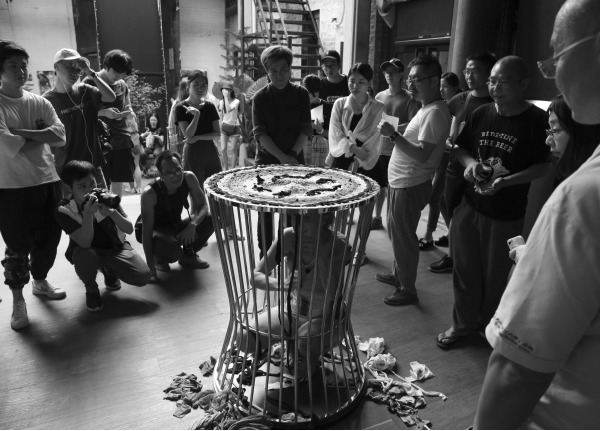
(C)AGING
first performed on September 15, 2018
Munan Ancestral Temple of Jian Family, OPEN festival, Guangzhou, China
performed once in 2018
DOROTHEA SEROR
Munich, Germany
858492236d858492236o858492236r858492236o858492236@858492236d858492236o858492236r858492236o858492236t858492236h858492236e858492236a858492236s858492236e858492236r858492236o858492236r858492236.858492236d858492236e
(C)AGING
DOROTHEA SEROR
I collected worn t-shirts from local people. An assistant and I started cutting the t-shirts into strips. An inverted table in the shape of a cage served as the frame for a weaving piece. When the audience arrived, I attached the warp threads and put myself in the “cage.” I locked the entry by making a weave over head over a period of several hours. I could not leave the cage either during the production of or after finishing the weaving. The audience, who either left and returned after some hours or stayed during the whole time, received a note with the following inscription:
Please try to find a way for the artist to get out without harming the art.
How to free the artist is up to the audience. In China, after an intense audience discussion, one guest unscrewed the tabletop from the frame so I could be free. The underside of the weave became visible, which in this case showed an I Ching pattern. Somebody began to auction the work with my consent. The auction once again raised the question of what the artwork actually is. In the end, the weaving piece was sold.
With this performance I deal with the question: where are the boundaries of art? Is not the performance artist who must be freed part of her art piece? What about the process of the creation of the weave and the liberation? The audience is afraid to destroy the uniquely woven rug, but is ready to disassemble the “golden cage” that also belongs to somebody else. Where are the limits of private property and public property? Is (ephemeral) art public property? Can artists generate works and show them in public and on art platforms without manipulating their work through current ideologies or demands of the inviting curators without “damaging” their own ideas?
Since the work was also part of my “long term” project on aging, I also show the changes and influences that aging has on my work. To work exclusively performatively, once a welcome expression for mobility, freedom and change, moves aside to the need to generate lasting objects in my art, to set signs and to leave behind values for the posterity.